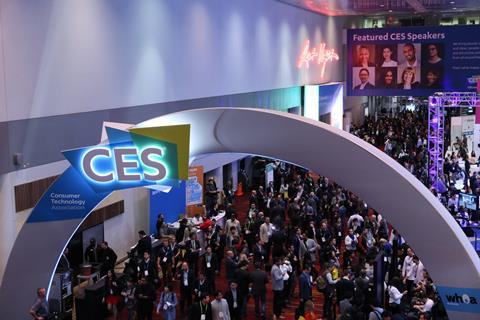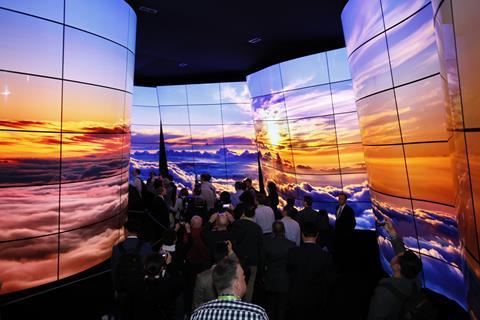Over-the-air (OTA) TV, higher definition content and immersive experiences were top of the agenda during the conference sessions at CES.
The future of broadcast has been a hotly debated subject, with many pondering the fate of linear TV, the extent to which we will use our mobile devices to watch content and how much of a threat the likes of Netflix and Amazon pose to the large, traditional broadcasters.

In January, the discussions continued as broadcast industry executives took to the Consumer Electronics Show (CES) in Las Vegas to talk about the current landscape, the trends we will see this year and their predictions for the future.
Game on for next-gen TV
The broadcast industry kicked off the conference with the long-awaited announcement of approval of the complete set of ATSC 3.0 next-generation TV-transmission standards.
President Mark Richer, alongside the CTA President and CEO Gary Shapiro and NAB President and CEO Gordon Smith, made the announcement during the first day of the conference, marking a five-year journey to make over-the-air (OTA) TV a reality for consumers.
According to the ATSC website: “ATSC 3.0, a suite of voluntary technical standards and recommended practices, is intended to allow substantial improvements in performance, functionality, and efficiency sufficient to warrant implementation of a non-backward-compatible system.”
Read more ATSC 3.0: Pathways to implementation
It is also expected to have a higher capacity to deliver Ultra High-Definition (UHD) services, robust reception on a wide range of devices, improve efficiency, IP transport and much more.
The standard is set to open more doors for linear TV, especially the sports TV industry, with consumers demanding more live sporting coverage from their broadcast providers, and 4K becoming more of a necessity than a fad.
But John Penney, EVP of Strategic Partnerships at Twentieth Century Fox, believes that this isn’t the only thing the consumers want from their TVs.
“We’re not the same person over 24 hours or over a week,” he explains. “Different devices and use cases change over time; place independent experiences will continue to grow, as well as picture quality, dynamics, and sound.”
4K adoption
During a panel discussion at CES on how TV will look by 2020, Tim Alessi, Director, New Product Development, LG Electronics, alongside Penney, discussed how higher-definition services are starting to come into their own.
“Sports will drive 4K adoption,” explains Alessi, highlighting the main use-case for ATSC 3.0. “The consumer needs to be able to watch as little and as much as they want.”

However, he was quick to point out that “no product [was at CES] yet,” though “a lot of work was being done to accelerate that.”
But there still concerns about privacy when it comes to ATSC 3.0.
Back in November 2017, when the standard was given approval by the Federal Communications Commission (FCC), many political figures raised concerns.
For example, when the standard approval was announced Michigan Representative Debbie Dingell said the new technology “contemplates targeted advertisements that would be ‘relevant to you and what you actually might want to see.’
This raises questions about how advertisers and broadcasters will gather the demographic information from consumers which are necessary to do targeted advertisements.”
VR and the TV experience
It’s been clear for a while that the user-case for VR is still to be determined.
Futuresource Consulting’s latest VR quarterly tracker, which assesses the challenges and opportunities faced in establishing VR as a mass market technology, shows that as 2017 progressed, the industry has adopted a more conservative viewpoint with regards to the speed of uptake of VR.
Many factors have conspired to limit widespread adoption of VR, and while the VR platforms have pushed ahead with hardware development, the creative community has lagged behind in its ability to generate a sufficient amount of compelling content.
“A key issue for the industry is the lack of killer applications for VR that are essential to drive consumer adoption, and this has proved to be a major limiting factor that has impacted growth,” says Michael Boreham, Market Analyst at Futuresource Consulting.
“The slow rate of consumer adoption of VR hardware has also impacted on the content community, with games and video publishers being wary of funding VR productions until the installed base of hardware has reached a level where they can guarantee a healthy return on investment.”
However, the broadcast industry seems to be taking advantage of virtual reality by bringing it into live sporting events.
Accedo CEO Michael Lantz has seen interest in VR from broadcast providers and sports associations in the past year. Through the company’s work with the Australian National Basketball League, Lantz notes that consumer behaviour seems to be positive towards the technology.
“Fans are prepared to pay a bit extra if you can provide something unique and extra in terms of experience,” explains Lantz. “With sports, the live core experience is premium in itself, so providers are asking ‘how can you justify the cost to consumers to bring real experience into the home?’ The answer is providing extra information and interaction through VR.”

According to Lantz, VR enables the consumer to experience sitting in the basketball arena as if they are there. They can enjoy the sounds and sights of the game, while also being provided information about the players, including statistics.
Dan Schinasi, Director, Product Planning - Consumer Electronics, Samsung, who was also speaking at CES alongside LG and 20th Century Fox, also thinks that backing VR is a viable investment for the broadcast industry, comparing it to 3D.
“[When it comes to VR] short-form content makes a lot of sense,” said Schinasi. “In a controlled environment, 3D worked, and VR will co-exist.”
Penney agreed with his counterpart, however, warned of the technical issues relating to VR: “VR is a new storytelling system, but it is morphing due to technical issues.
“3D VR has yet to be defined,” he goes on to explain. “… and will depend on the compute power available.”
But analysts at Futuresource remain sceptical: “VR remains a mass market home entertainment product in waiting,” says Boreham. “Technology continues to improve; the consumer cost of entry is falling and there is further experimentation with content creation and monetisation models.
“With continued heavyweight industry support from the hardware sector and the content community, it remains a question of when rather than if the consumer VR market will achieve mass market acceptance. Although, this is expected to occur over a longer timeframe than was initially anticipated.”
Preparing for 8K
While the telecommunications industry focuses on the next generation of connectivity, known as 5G, it seems like the broadcast industry is turning its attention to 8K.
For many, there is still a question mark over the success of 4K mass-adoption, and so some are baffled as to the new emerging trend of “8K”, also known as 8K UHDTV. However, that hasn’t stopped the likes of LG, Sony and Samsung launching new 8K television screens during CES 2018.
However, as pointed out during the “What will TV look like in 2020?” panel, it has never been a device issue when it came to making 4K a standard; it was the content.
“When HD and 4K were launched, there wasn’t any content, which resulted in delays,” explains Alessi, LG Electronics. “The buying factor [for 8K] is realistic picture quality; higher frame rate from a hardware side will happen.”
However, Schinasi warns: “Senior manufacturers are ready for [8K] but content creators are not.”
Carl Hibbert, Head of Consumer Media & Technology at Futuresource, is also concerned about the impact 8K would have on original content providers: “8K is a natural progression, but the issue is what are consumers going to watch? There is limited production.”
























No comments yet